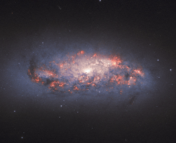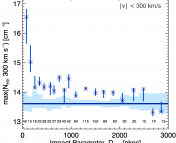Title: ALMA Deep Field in SSA22: A near-infrared-dark submillimeter galaxy at z = 4.0
Authors: H. Umehata, I. Smail, A. M. Swinbank, K. Kohno, Y. Tamura, T. Wang, Y. Ao, B. Hatsukade, M. Kubo, K. Nakanishi, and N. N. Hayatsu
First Author’s Institution: RIKEN Cluster for Pioneering Research; Institute of Astronomy, The University of Tokyo
Status: Published in Astronomy & Astrophysics [open access]
Dust cloaked, massive starburst galaxies are integral to our theories of galaxy formation and evolution, but to our eyes and optical telescopes, they’re hiding in the dark. In these distant, dusty star-forming galaxies (DSFGs), light from their many new stars is emitted in optical and near-infrared (OIR) wavelengths, then absorbed and reradiated by dust at longer (sub)millimeter wavelengths. This cloaking effect from dust can make even the most extreme, hyper-luminous starbursts nearly invisible in the OIR, making observations challenging.
Near-Infrared Dark Galaxies
Looking to longer wavelengths with high precision instruments like the Atacama Large Millimeter/submillimeter Array (ALMA) can help us see in the dark and resolve DSFGs further and further away. In their recent paper, Umehata et al. report the discovery of one such distant “near-infrared dark ALMA galaxy”, which they define as galaxies detectable in (sub)millimeter wavelengths that are undetected in deep OIR images, as illustrated by Figure 1.

Figure 1: From left to right, the first 6 panes show a continuum observation of ADF22.A2 in bands increasing in wavelength from near-infrared to (sub)millimeter. The 3 rightmost panes hone in on specific emission signatures that trace molecular gas. The galaxy is undetected in shorter wavelength Ks band with traditional OIR telescopes, and strongly detected at longer (sub)mm wavelengths with interferometric dishes. Figure adapted from Figure 2 in Umehata et al. 2020; electromagnetic spectrum line drawing adapted from Wikipedia.
Initially, the authors had taken deep ALMA observations to survey galaxies in the field of view of a well known protocluster, a dense and unsettled system of galaxies starting to form a cluster of galaxies. This protocluster, SSA22, is like a big fireworks show, rich with active galaxies and starbursts at the intersection of high density filaments of the cosmic web. SSA22 is putting on its fireworks show about two billion years after the Big Bang, or at redshift z ~ 3.1.
However, today’s paper reports a galaxy even more distant, sitting behind the fireworks show. While observing in the field of view of SSA22, the authors discovered a new target in the background of the protocluster, a more distant galaxy at redshift z ~ 4, dubbed ADF22.A2.
The authors then used spectroscopic and photometric observations spanning multiple wavelength regimes to infer some of the galaxy’s key physical properties like its stellar mass (~1011 M☉), intrinsic infrared luminosity (~5 x 1012 L☉), molecular gas mass or amount of star formation fuel (~5 x 1010 M☉), and star formation rate (~400 M☉/yr). Compared to our home Milky Way Galaxy, ADF22.A2 is much more infrared-luminous due to higher star formation activity, more gas-rich which fuels that star formation, and ultimately produces stars at a rate hundreds of times higher. From these estimates, they found the characteristics of ADF22.A2 to be consistent with other massive DSFGs.
Putting the Dark Discovery in Context
So how does this galaxy fit into the story of galaxy evolution? The authors conclude the discovery paper by painting a picture of active, star-forming galaxies like ADF22.A2 settling down into quieter, non star-forming galaxies over time. Astronomers have been identifying more and more quiescent (or non star-forming) galaxies at high redshifts of z ~ 3 – 4 (like the galaxy covered in this Astrobite), surprisingly early in the history of the universe. These quiescent galaxies must have already gone through active, star-forming phases at higher redshifts, so the mere existence of passive galaxies at z ~ 3 – 4 requires there to be active galaxies at z > 4.
With a somewhat depleted gas-mass fraction (the relative amount of the galaxy’s mass in gas, the fuel for star formation) of 35% and a high stellar mass of ~ 1011 M☉, the authors suggest ADF22.A2 must be moderately evolved and has already churned through a good chunk of its gas supply and turned it into stars. At this rate, assuming it maintains star formation at 100s M☉/year, by redshift z = 3.6 – 3.8, ADF22.A2 should consume its gaseous fuel reservoir and retire into a quiescent stage.
The discovery and analysis of this galaxy is just one snapshot of the formation and evolution of massive galaxies. With additional deep ALMA observations, researchers can start to piece together the whole story when it comes to these dark, dusty galaxies.
Astrobite edited by Roan Haggar and Ellis Avallone
Featured image credit: ESO/M. Kornmesser




